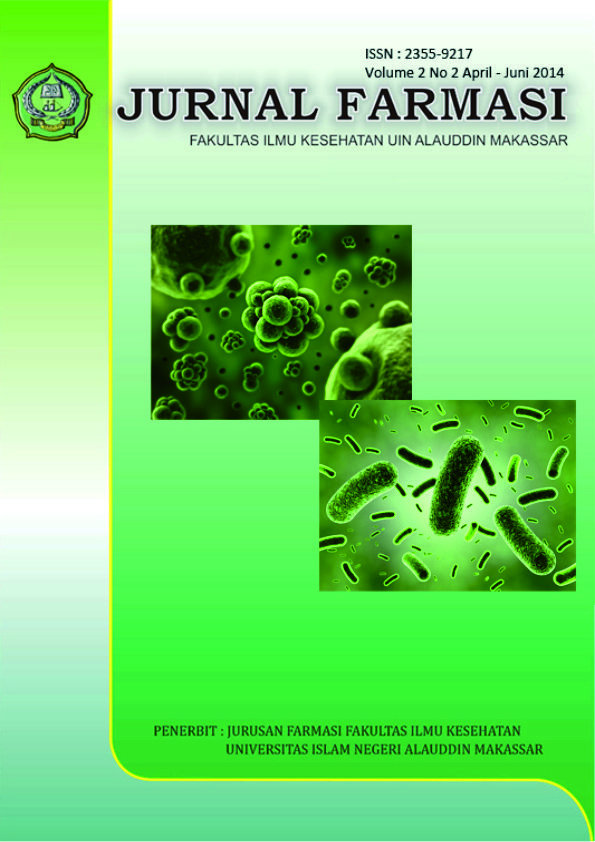STUDI HUBUNGAN KUANTITATIF STRUKTUR-AKTIVITAS (HKSA) DAN DOCKING MOLEKULER SENYAWA TURUNAN OXABICYCLOHEPTENE SULFONAMIDE (OBHS) SEBAGAI ANTAGONIS RESEPTOR ESTROGEN- α PADA TERAPI KANKER LEHER RAHIM (SERVIKS)
Abstract
A research study of quantitative structure-activity relationship (QSAR) and molecular docking of Oxabicycloheptene Sulfonamide (OBHS) derivates as Estrogen Receptor α (ERα) antagonist in Cervical Cancer treatment was performed. This study aims to find similarities QSAR models of Oxabicycloheptene Sulfonamide derivates as ERα antagonist and assess the interaction model of Oxabicycloheptene Sulfonamide derivates towards the side of the ERα (pdb code: 1G50 and 3ERT) binding (binding site). In this research tested against 9 Oxabicycloheptene Sulfonamide derivate compounds. The first, drawing compounds and ab initio optimization at the HyperChem program. Further test descriptor values, statistical calculation method multilinier regression analysis, z-score validation and Leave-One-Out validation method. Obtained from experiments performed equation : log 1/IC50 = 5.2006 + (- 3.52E-06 AM1_Eele) + (4.46E-05 AM1_HF) + (0.5737 log S) + (0.8919 mr) + (-0.0392 vol), which n = 9, r2 = 0.9404, and q2 = 0.7388. In the process of molecular docking, ligand and receptor preparation done first before to performing docking simulation. Obtained results from docking to protein code 1G50 experiments which compound 13 showed better results with a docking score (S) -12.2016. Then, results from docking to protein code 3ERT experiments which compound 12 showed better results with a docking score (S) -10.3484.References
Abraham DJ, Burger’s Medicinal Chemistry and Drug Discovery. 6th ed. Volume 1.. New York Willey Interscience. 2003 : h. 289
American Cancer Society. Cervical Cancer. American Cancer Society: USA. 2013.
Andriyono. 2003. Kanker serviks. Sinopsis Kanker Ginekologi. Jakarta.
Erin K. Shanle, Wei Xu. Selectively targeting estrogen receptors for cancer treatment. Adv Drug Deliv Rev. 2011. Vol. 62 (13): h. 1265–1276
Gao H, Nishida J, Saito S dan Kawabata J. Inhibitory Effect of 5,6,7- Trihydroxyflavones on Tyrosinase. Molecules. 2007 : h. 12, 90.
Jitender Verma, Vijay M. Khedkar, Evans C. Coutinho. 3D-QSAR in Drug Design - A Review. Medicinal Chemistry. 2010. 10: h. 95-115
Manghong Zhua, Chen Zhang, Jerome C. Nwachukwub, Sathish Srinivasanb, Valerie Cavettb, Yangfan Zhenga, Kathryn E.
Carlsonc, Chune Donga, John A. Katzenellenbogenc, Kendall W. Nettles, and Hai-Bing Zhou. Bicyclic core estrogens as full antagonists: synthesis, biological evaluation and structure–activity relationships of estrogen receptor ligands based on bridged oxabicyclic cor arylsulfonamides. Org Biomol Chem. 2013. 10 (43): h. 8692–8700.
Patrick, G.L. 2009. An Introduction to Medicinal Chemistry edisi ke-4. Oxford University Press: New York Philipp Y. Maximov, Theresa M. Lee, V. Craig Jordan. The Discovery and Development of Selective Estrogen Receptor Modulators (SERMs) for Clinical Practice. Current Clinical Pharmacology. 2013. 8: h. 135-155
Sang-Hyuk Chung, Silvia Franceschi, Paul F. Lambert. Estrogen and ERα: Culprits in Cervical Cancer?. Trends Endocrinol Metab. 2010. 21(8): 504–511
Department of Health and Human Services. 2012. Cervical Cancer. CDC Publication: US.

